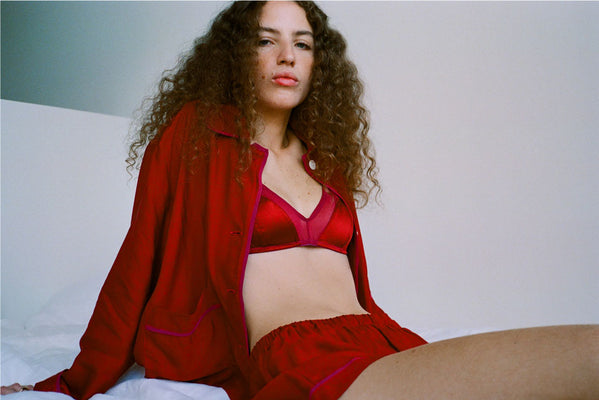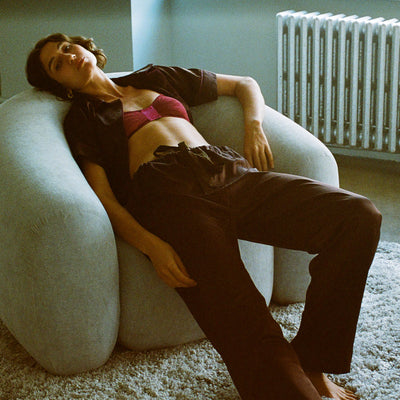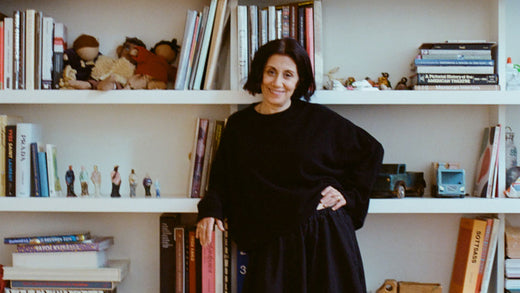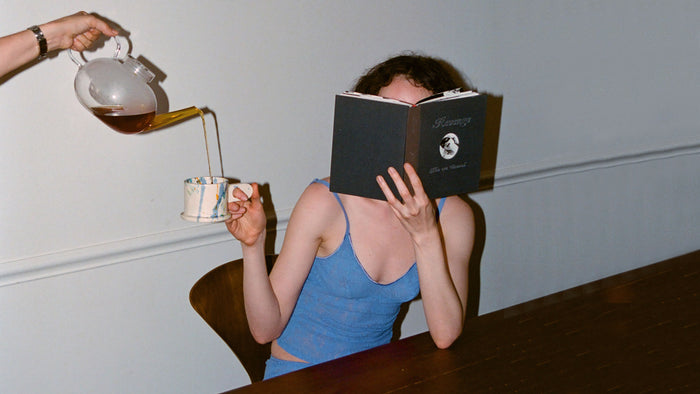JOURNAL

We’re always searching for bits and pieces of magic to complement our collection–pieces that reflect our love for artful design, craftsmanship, and color. When Araks discovered the world of interdisciplinary artist Wilder Alison, she instantly fell in love. It was a serendipitous moment to find that Alison creates beach towels, aligning beautifully with our vision, and complementing our swimwear collection.
Created from 100% jacquard-woven cotton and produced at one of the last remaining terrycloth manufacturers in the USA, Alison’s towels are a work of art in themselves. Two limited edition towels are now available at our Soho store and online.
Can you tell us about your upbringing? What was your childhood like, and how was creativity and self-expression cultivated in your adolescence?
Although I am the only artist in my family, I grew up with a strong culture of making - my parents were very accommodating of my creative drives. My dad is a biomedical engineer, mad-scientist type, and it seems he has imparted to me a sort of "scientific method" that we each apply to our rather singular passions. My mom grew up in a Finnish community in rural Vermont and she and my grandmother passed down quilting and knitting traditions to me - these practices were strongly affiliated with values of thrift and reuse, and when I was a kid we spent a lot of time going to yard sales, where we would find craft supplies and materials, and sometimes old quilts. I also grew up close to the Shelburne Museum, a colonial living history museum in Vermont with a well-known quilt collection. We moved to the midwest when I was young, and it was very difficult for me to leave the mountains of the northeast. I somewhat attribute my artistic dedication in my childhood to having been confronted by what I felt was an absence of nature in my new environs. My making was self-directed and constructive, and I explored a wide range of materials as a teenager - making clothes, mosaic, stained glass, screen printing, dyeing, video, photography. I also sang for many years.
Can you share a little bit about your background as an artist.
I have worked with textiles since I was small, but my art education revolved more around sculpture, installation, printmaking, music/performance, and eventually painting in graduate school. Most of my creative pursuits took place outside of school until college. I went to Bard, which is not officially an art school, but being there gave me the freedom to pursue making what I wanted to make - and I generally had to figure out the technical aspects of that on my own. I moved to Brooklyn after school and spent several years there finding my community and refining my practice while also leaving town to do artist residencies whenever possible.

We love that some of your work involves wool blankets, dyed in a palette of four to six colors and then cut and sewn into a final composition. What attracted you to the mediums of fabric and dye rather than paint and canvas?
It was fabric and dye that led me to making works stretched on canvas. I have been working with wool since my childhood, and I began making the paintings I now refer to as “slit subjects” out of wool starting in 2014. I found some army blankets at an antique store and I was working with food dyes. At the same time I had discovered a text by Monique Wittig called The Lesbian Body, in which the “I” - the “je” - in the original French version is cut by a slash. And in the English version the translator made the decision to italicize the “I” - such that the I itself functions as a slash cutting the text. Motivated by this intervention in Wittig’s “I,” I created a cutting structure that would allow me to make a wide range of compositions out of simple dye patterns I created on these blankets. This process has evolved and I am now making more elaborate compositions using this framework. I think of the textual origin of the work as part of its materiality.
The way that I process and stretch the wool means that in the final forms of my paintings, the material resembles raw canvas from a distance, but there is a compelling dissonance in the texture of the dye patterns that leads you to understand that the material is not canvas - it is not really a painting at all. I have always been drawn to the way wool brilliantly absorbs dyes, and I find that my paintings have an almost backlit, screen-like quality because of this intense level of color saturation. Unlike paint, which is comprised of pigment - a particle - dye changes the chemical structure of the fabric: the color in my paintings goes all the way through the material rather than resting on the surface like paint and pigment would.

How do you approach the use of color in your paintings, and what role does it play in the overall impact of your artistic expression?
I don’t have a straightforward explanation for this because I take an intuitive, poetic approach to my color choices. I use color associatively, in pursuit of a range of moods and syntaxes in the combinations of colors I use. So you could think of each distinct palette within a painting as a kind of “spelling” of a word I am inventing on the spot, although of course there are many more possible colors at my disposal than letters in the alphabet.
Perhaps the interesting parts of this process come about relationally: I am interested in the impossibility of reproducing these works, either within a diptych that has two panels of the same dye schema, or between two or more separate works. So I will sometimes try to reproduce a color palette from an earlier painting in order to make it again.
To re-make these compositions is like handwriting insofar as there are contingencies to how my body moves and how the dye behaves, and so each resulting “character,” if you will, always comes out slightly differently. Because I am working loosely with the powdered dyes, trying to match a previous color based on a painting or a drawing, often working under different lighting conditions than the previous version, these reproduction attempts yield palettes that are related but dissonant. I do not consider this shift to be an error, but as something more like a refresh - it is a desirable result for me.
The color aspect is also relational in that I dye the wool for many paintings at once - working according to schematics, for example, I will dye a sequence of several blues for several different works, adjusting the color in the pot as needed by adding more dye. This helps me save both water and time, as the dye pots take a while to heat up.
This process means that a group of paintings share in the same “genetic material” of the contents of the dye pots. Each act of dipping the wool into the dye pot also inflects the next dip, because each dip effectively removes some of the dye from the dye pot and therefore changes the color that remains in the pot. This means there is a kind of collectivity to how I compose the color of the dye in the pot - though because I can’t see the true color by looking at the dye bath, the color is only revealed by putting the wool into the dye and removing it again.
Photo: Sarra Fleur Abou-El-Haj
|
What prompted you to start designing towels?
A while back I found out about Plunge, a company that facilitates the production of towels designed by artists, through the work of Lukaza Branfman-Verissimo. When Kate Levant at KAJE asked me if I wanted to make an edition before my show there last fall, I immediately knew I wanted to create a towel.
I have spent significant periods of developing my wool painting project while living by - and responding to the cycles of - the sea, particularly in Provincetown and Marseille, where I am now. While I'm dyeing fabric for my paintings, the wool is often soaking wet and dripping, and there is water everywhere in the studio. Furthermore, the original inspiration for these paintings was a text by Monique Wittig called The Lesbian Body, which is quite corporeal and visceral. For all of these reasons, it made sense to me to make an object that is meant to cycle between wetness and dryness in relation to the body. I also simply wanted to make a more accessible version of my paintings available.
Where are your towels are made, and can you share a little about the production process?
The towels are woven in the US on jacquard looms, and apparently three colors is the capacity for this type of terrycloth weaving currently possible in the US.
Next month, I am releasing a new towel at Das Minsk Kunsthaus in Potsdam, Germany in conjunction with a textile group show SOFT POWER that I am part of. These towels will be made by Towel Studio in Berlin with a knitting process, which has presented a different kind of flexibility with respect to my compositional and color choices. This project came about directly in response to the KAJE production, and I'm so glad that I will soon have towels available in Europe.
|
 |
What are you currently…
Coveting?
I'm waiting for Hirbawi kufiyas to be available again.
The jewelry of Jacob, a French designer I discovered recently.
A knitting machine.
Watching?
I’m planning to embark on a deep Miyazaki dive since I have somehow neglected his oeuvre thus far
Listening?
I'm doing the cover for an upcoming album by my friend Judith Hamann, so - that.
Also, the only podcast I consistently follow is Wardrobe Crisis, which is about sustainability in fashion.
Reading?
I've been reading both of Qiu Miaojin's books. I'm looking forward to cracking the collections of essays by Nick Mauss and Estelle Hoy that After8 in Paris just put out.
Dreaming?
The wherewithal to make myself jeans
Giving?
I give my friends clothes I've made and novels after I finish them
Thank you, Wilder!
Follow Wilder @wilderalison
Shop the towels.















